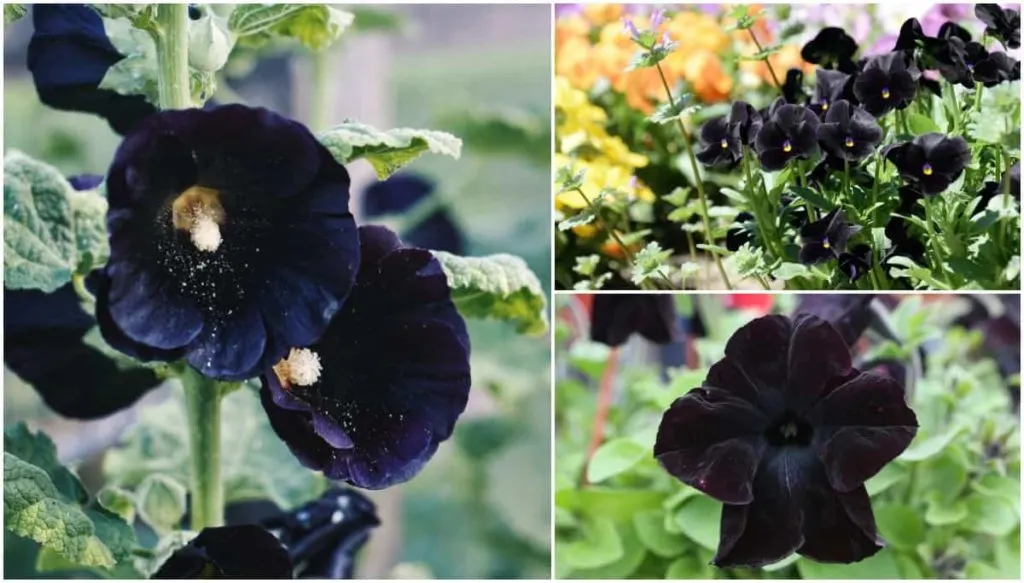
There’s no doubt about it – black flowers add a touch of dramatic intensity to any landscape. They add a new meaning to the phrase ‘black goes with anything’.
Truly black blooms are rare, and most flowers marketed as black are actually deep red, blue, or purple. While the deepest black flowers may be the goal, those with the glints of maroon or edges of purple add a sense of dimension to garden designs.
The sunlight requirements differ per species, but most look their best in full sun. Not only will they benefit from the extra rays, but the sunlight will highlight the depths of the flowers’ darkness.
Black blooms stand out best when planted against a backdrop of bright foliage or amongst brighter, lighter flowers.
1. Columbine ‘Black Barlow’
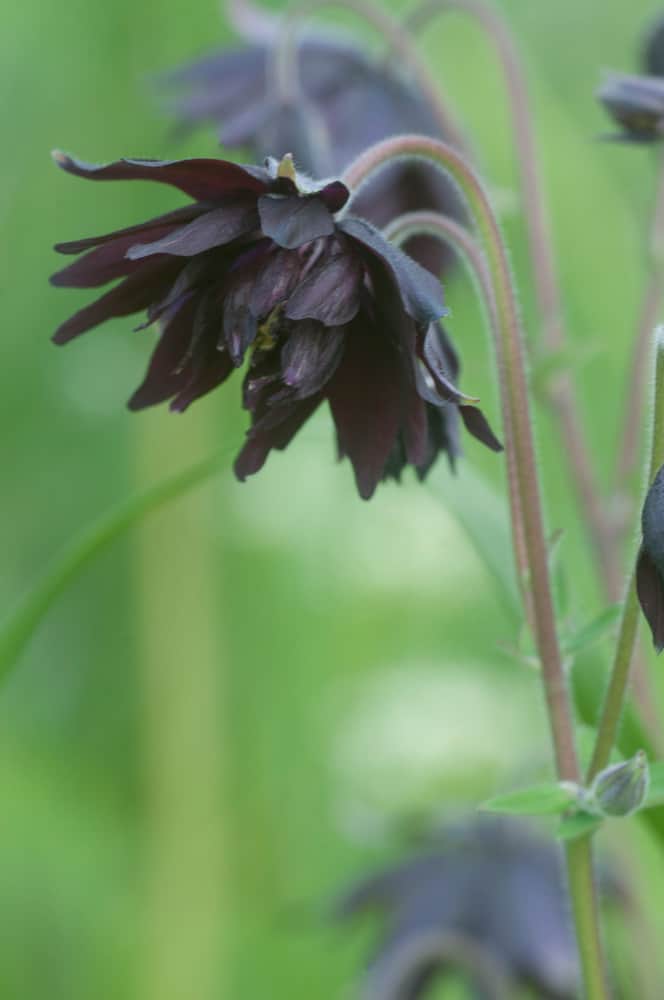
This spectacular flower has been specifically bred for cut flower production, a wonderful addition to cut flower gardens. ‘Black Barlow’ is the first cultivar of the Barlow series that has double, spurless flowers. These double blooms are deep plum, almost black, and resemble pompoms with their spikey petals.
These striking black blooms sit on long stems, towering over the bushy, grey-green foliage. They tend to grow in clumps, creating a true dark spectacle, perfect for a unique cottage garden border.
‘Black Barlow’ flowers bloom in late spring to early summer and are generally short-lived. However, its self-seeding nature allows them to grow profusely, given the right conditions. ‘Black Barlow’ is an easy plant to care for, thriving in most conditions and growing best in USDA zones 3 to 9.
2. Iris ‘Before the Storm’
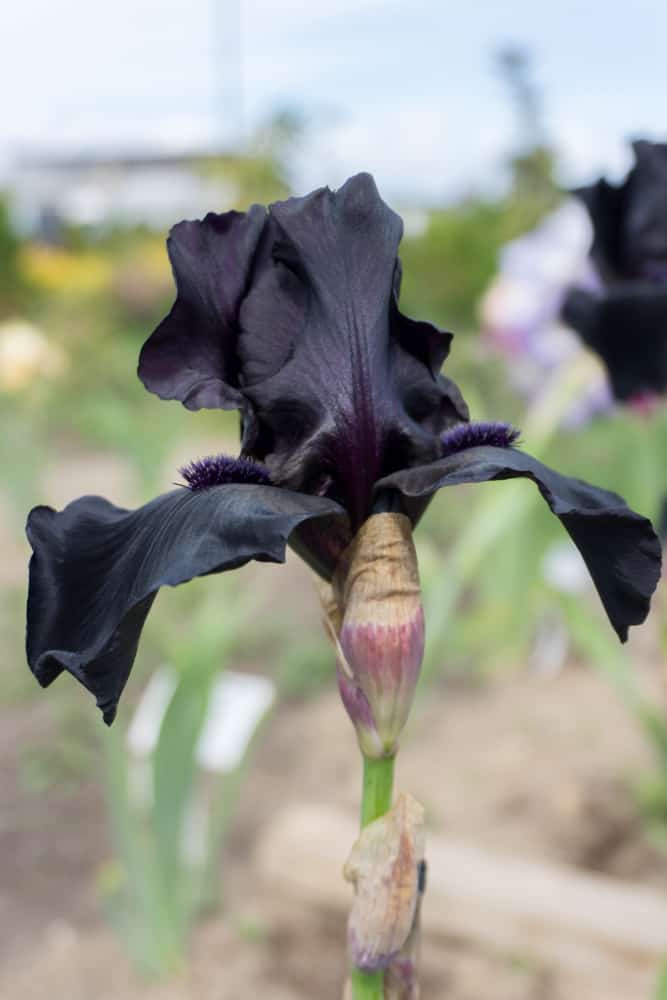
Bearded irises are some of the most popular flowering perennials, so much so that they’ve become a garden staple. Irises come in a myriad of colors, including dark, almost black hues. ‘Before the Storm’ is considered the darkest iris available with its deep purple flowers.
As with any iris, ‘Before the Storm’ adds elegance to any space. These stunning flowers hover above striking silver-green, sword-shaped foliage. Each stem can produce around a dozen flowers that bloom throughout spring and early summer. These flowers also have a deliciously sweet fragrance.
‘Before the Storm’ looks best planted on its own in containers or along borders. The sharp foliage paired with softer-edged flowers also adds interesting texture to modern and traditional landscapes alike.
3. Rose ‘Black Baccara’
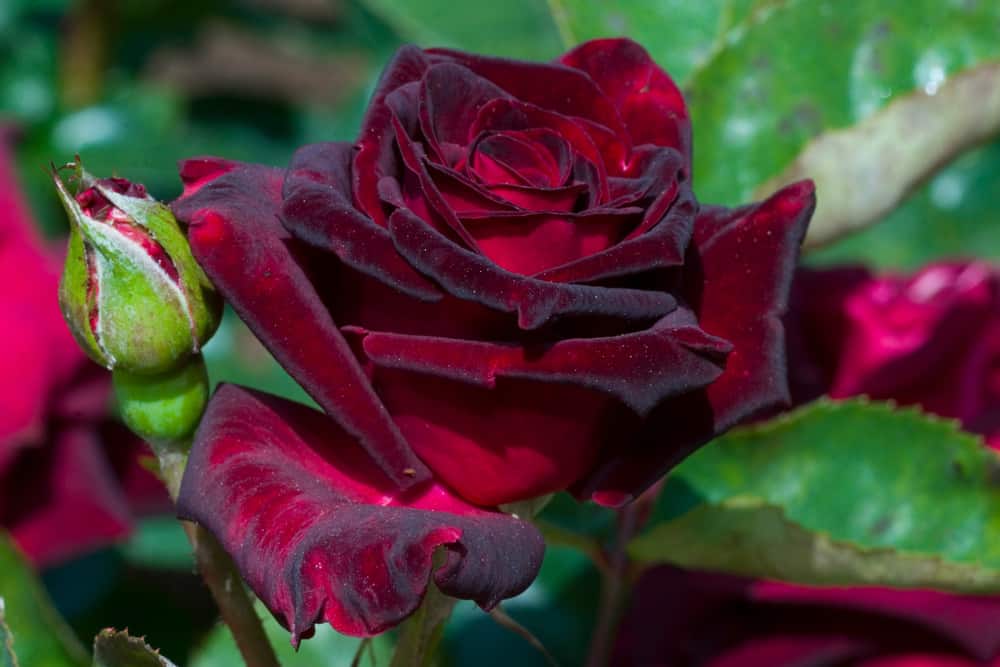
The ‘Black Baccara’ rose is a hybrid tea rose with deep, dark maroon petals that appear black. It was developed in 2005 and is regarded as the darkest rose on the market.
Other black roses, like the equally beautiful ‘Black Magic’ rose, don’t come close to Baccara’s dark hue. The rose is a very full flower, boasting many red-black velvet-like petals. The bush’s dramatic flair is only increased by its dark green and glossy foliage.
‘Black Baccara’ rose has a long flowering season, blooming in flushes between spring and fall. It’s hardy in USDA zones 5 – 9, tolerating most climates and conditions. This dramatic rose also prefers the spotlight, needing to be planted in full sun.
‘Black Baccara’ may be a moody addition to your garden, but it brings a touch of life to spaces by attracting butterflies and other pollinators.
4. Black Bat Flower
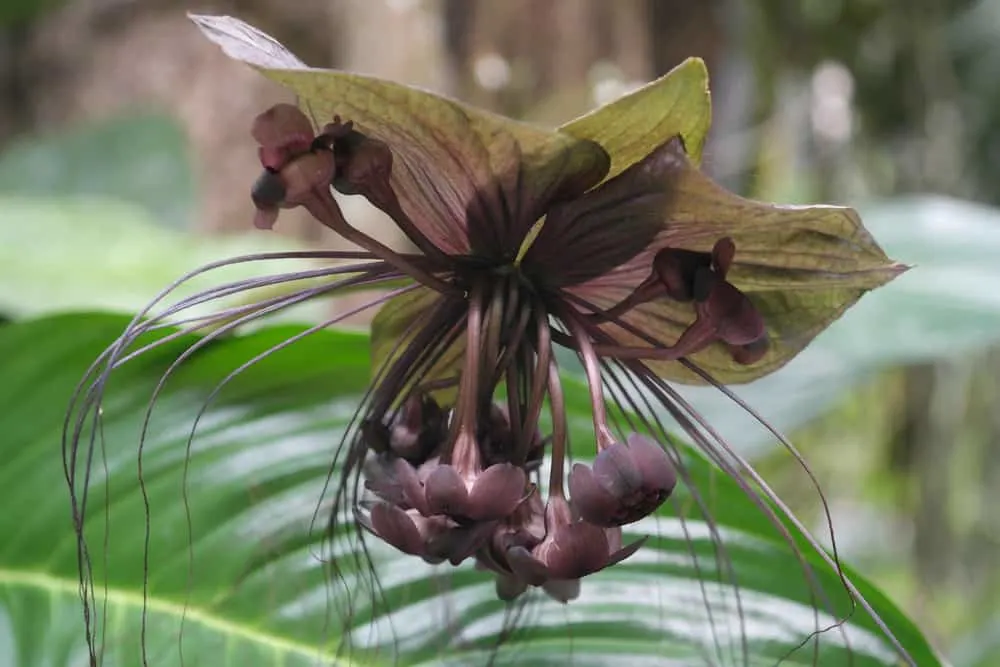
The Black Bat flower gets its name from its outlandish looks that look like a bat in flight. This rare plant has deep purple-black ruffled flowers and long, hanging filaments. Adding to its battiness are its seedpods, which resemble small bat faces. These unique blooms are offset by large, bright green leaves.
Tacca chantrieri are finicky plants, needing close care and attention. They thrive best in USDA zones 9 – 11, preferring warm, moist tropical climates. The Black Bat Flower doesn’t tolerate cold climates at all, often dying if temperatures dip below 55F. Unlike other black flowers, it prefers dappled shade over the full sun.
This exotic flower may need some extra TLC, but the extra work is well worth the moody, dark display of its unique flowers.
5. Dahlia ‘Karma Choc’
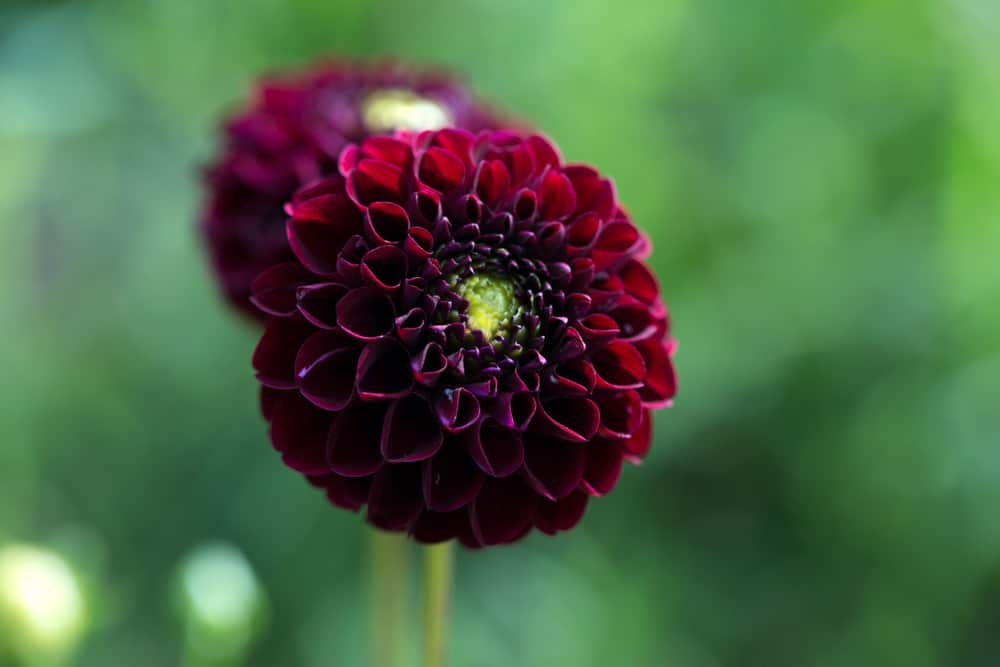
The ‘Karma Choc’ dahlia is often considered the darkest dahlia available. Its flowers are a mass of dark red velvet petals that fade into an almost black center, creating a unique ombre effect. These dark blooms tower over the plant’s foliage, which is a dark, blue-tinted burgundy.
This dark beauty belongs to the Karma collection, which was specifically bred to have long-lasting cut flowers. These dark blooms have an astonishing vase life of almost two weeks, making them perfect for cut flower gardeners.
‘Karma Choc’ may be bred for vases, but its stunning display of flowers makes it a spectacle in the garden too. They add a dash of darkness to borders and containers and are prominent features in moody garden designs.
6. Hyacinth ‘Dark Dimension’
If you’re a fan of Hyacinths and dark, almost black flowers, then the ‘Dark Dimension’ cultivar is perfect for you.
‘Dark Dimension’ sports purple-blue star-shaped flowers that are as dark as the night. These dark blooms are densely packed, adding to their mysterious allure.
About 10 to 20 buds stem from each thick stalk of this hyacinth, creating an otherworldly dark flower display. These flowers grow amongst deep green sharp foliage that adds some angled texture to this soft plant.
‘Dark Dimension’ grows best in USDA zones 4 – 8 and can survive frost-filled winters with temperatures as low as 20F.
This dark hyacinth is a great addition to spring gardens filled with brightly colored flowers. Its dark blooms make lighter flowers pop, adding some depth to your landscape. ‘Dark Dimension’ also has a lovely fragrance that attracts bees and other pollinators.
7. Calla Lilly ‘Black Star’
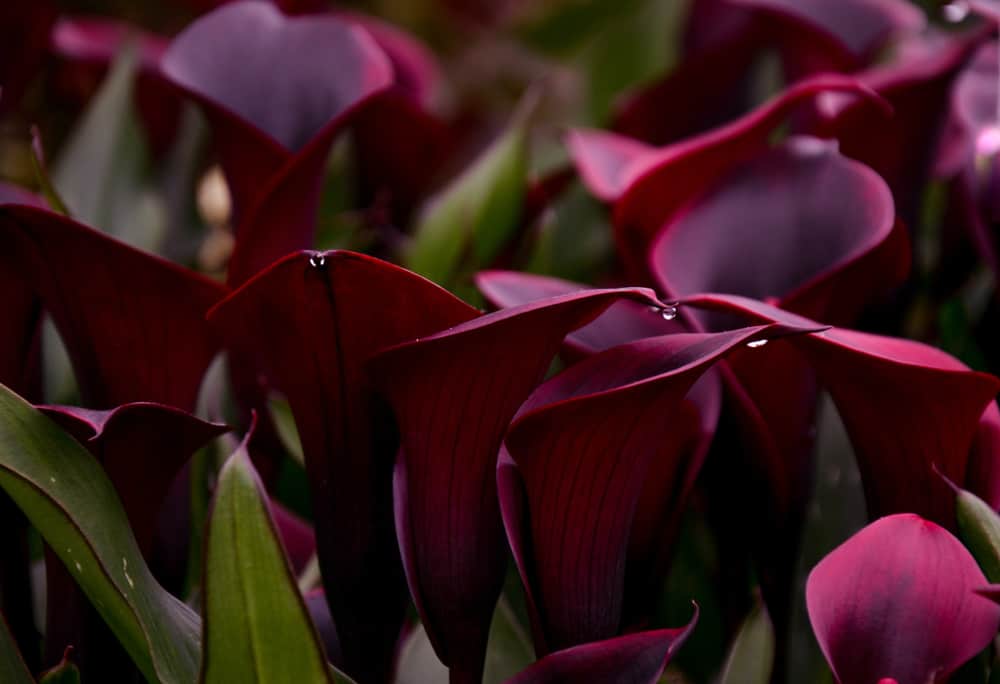
Calla lilies are unique, with trumpet-like flowers that stand out no matter where they’re planted. The ‘Black Star’ Calla Lilly creates a darker mood than other varieties and cultivars. ‘Black Star’ blooms are a deep, almost black burgundy growing from matching dark stems. These tubular blooms are highlighted by bright, speckled green foliage.
The ‘Black Star’ not only adds some drama to your landscape, but its sleek blooms also add a touch of modern elegance. It looks great when planted in clumps amongst other brighter blooms or on its own. It also flourishes along beds or in container gardens.
‘Black Star’ adds drama to gardens between late spring and summer and thrives in USDA zones 9 – 11.
8. Petunia ‘Black Velvet’
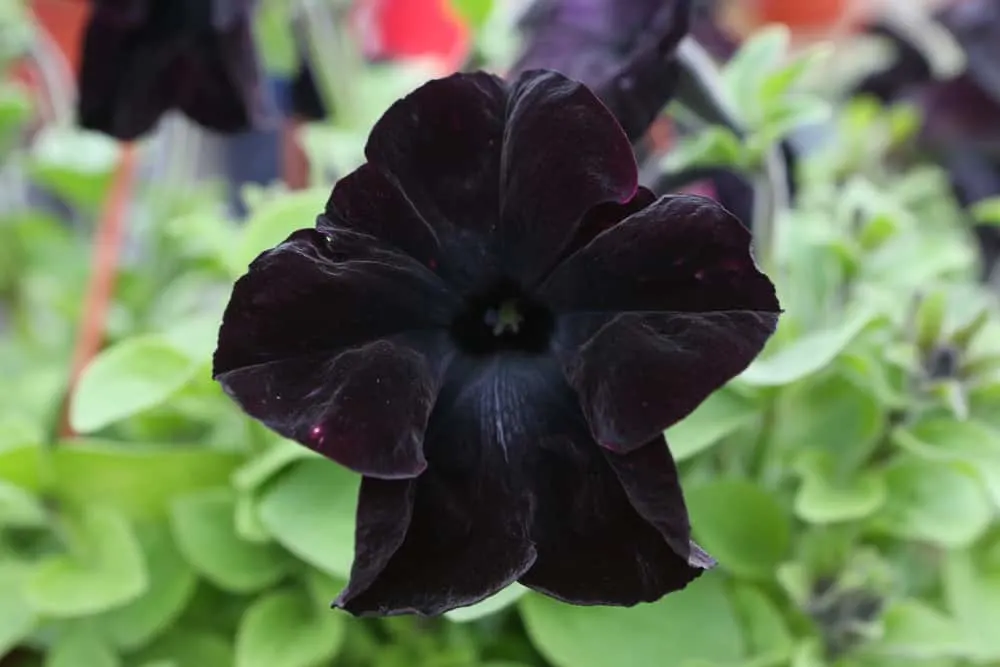
‘Black Velvet’ Petunias are amongst the darkest flowers available. Developed in 2010, it was the first black petunia on the market.
‘Black Velvet’ flowers are not only the closest to true black, but they’re also uniquely shaped like a trumpet. This trumpet attracts butterflies and hummingbirds to your garden. The dark petals have a velvety feel, hence their name, and are offset by light green foliage.
These almost true black blooms can create a modern, minimalist look if planted in droves. However, they make just as much of an impact when planted in beds with colored flowers.
‘Black Velvet’ petunias bloom throughout spring, summer, and fall. They thrive in USDA zones 9 – 11 and are generally easy to care for. Black petunias aren’t strong flowers and need some added protection from cold, heavy rain, and wind.
9. Hollyhock ‘Nigra’
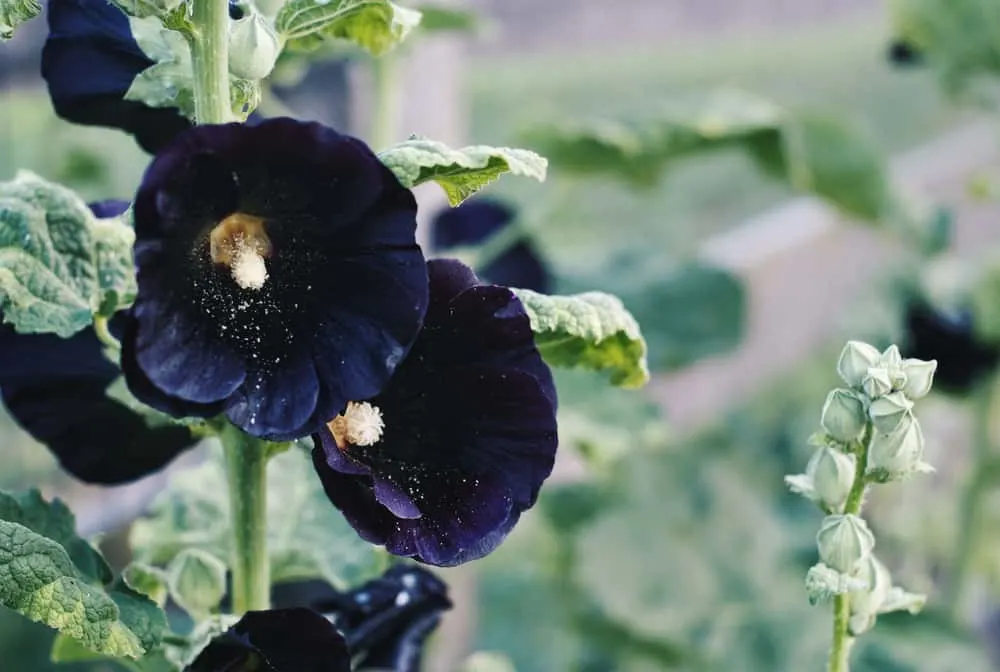
A common flower in gardens is Hollyhock, often making bold statements with their bright flowers and height. The black hollyhocks are an even bolder choice, particularly the ‘Nigra’ cultivar.
The flowers of the ‘Nigra’ are waxy and a deep purple-black. Their darkness is extenuated by the flowers’ light, creamy centers. The ‘Nigra’ hollyhock has been adding dramatic mystique to gardens since the 17th century, often being used as bed backdrops. It’s hardy in USDA zones 3 – 9 and blooms in mid to late summer.
Mature hollyhocks can reach anywhere between five and eight feet tall, making them the perfect fence liner. The darkness of the ‘Nigra’ is the perfect hollyhock cultivar for those wanting a splash of black but a classic look.
10. Viola ‘Blackout’
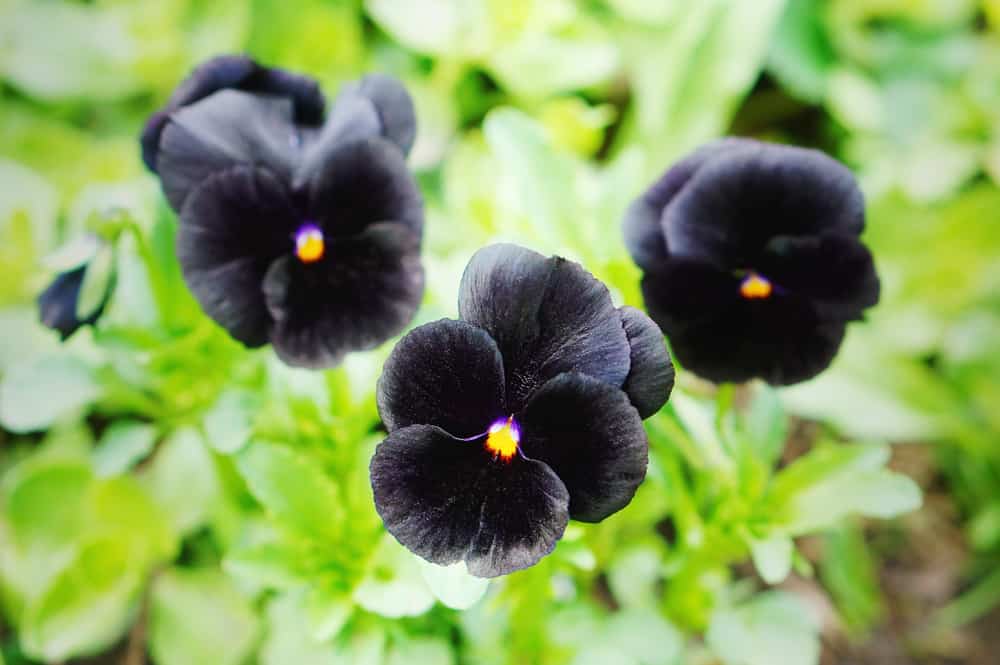
Violas are a classic addition to gardens, suiting window boxes and cottage-style gardens best. ‘Blackout’ violas spice up the classic look with dramatic flowers that are velvety black. The depth of these black flowers is accentuated by the yellow eye and bright green foliage.
These black violas are popular not only for their looks, but for their sweet fragrance and easy-going nature. They flourish in most conditions, thriving in USDA zones 6 – 10. While ‘Blackout’ violas can grow in full sun, they prefer some shade in hotter climates. They’re also vulnerable to frost and will need some form of winter protection.
These elegant blooms are ideal for ground cover, but they do make unique additions to rock gardens and window boxes too.
11. Lenten Rose ‘New York Night’
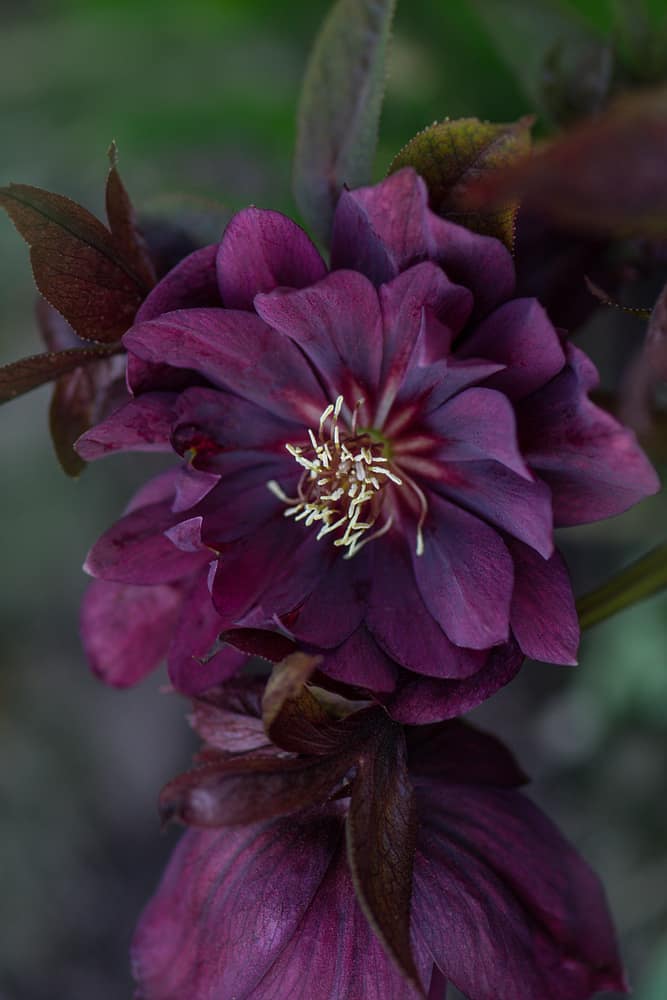
Helleborus, commonly known as Lenten Rose, typically have pastel-colored flowers. But the ‘New York Night’ cultivar has large, dark purple or almost black cup-shaped flowers. They bloom in early spring, ending winter with a dramatic flair.
The dark blooms are accompanied by glossy green foliage that stays green throughout the year in warmer climates. The ‘New York Night’ Lenten rose is hardy in zones 4 – 9 and can thrive with little fuss. It also flourishes in shade and poor soil conditions, making it the perfect addition to deserted shady patches.
‘New York Night’ makes an eye-catching edging plant and an alternative to classic cottage garden flowers.
12. Pansy ‘Black Beauty’
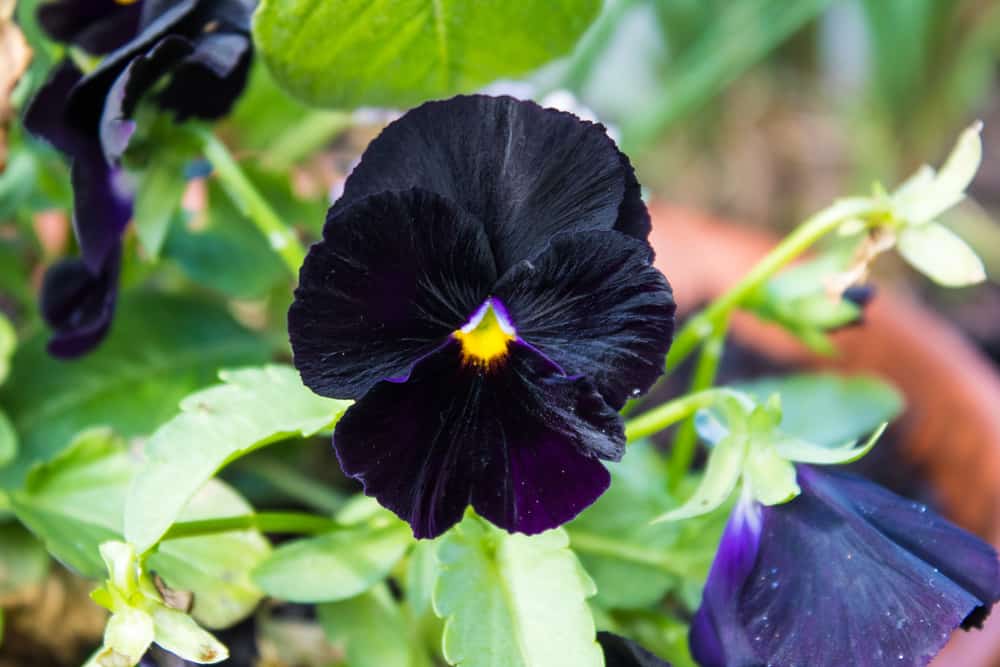
Like violas, pansies are garden staples, suiting a variety of garden designs from traditional gardens to urban container landscapes. ‘Black Beauty’ Pansies are a great traditional flower with a striking, moody twist. These pansies have extremely dark purple flowers that add a hint of gothic spookiness wherever they’re planted.
Adding to the allure of the ‘Black Beauty’ is its cold hardiness and ability to survive the frostiest winters. Often, these blooms look their gloomiest when poking through glistening snow and frost. ‘Black Beauty’ Pansies typically thrive in USDA zones 5 – 9.
To get the most out of these plants, pair them with other bright flowers. This contrast works well, especially when planted in shadier beds.
13. Tulip ‘Queen of Night’
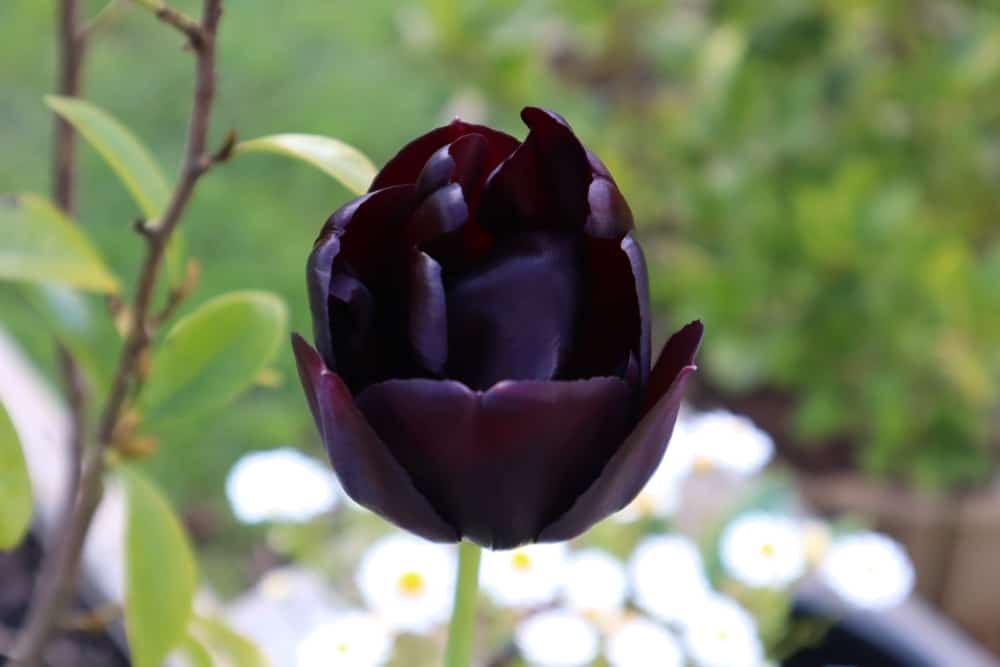
Tulips are highly sought-after flowers, but their color palette doesn’t suit everyone’s taste or dark aesthetic. ‘Queen of Night’ Tulip is here to save the day with deep maroon flowers. Its reddish hue is so close to black that this Tulip is the darkest on the market.
Like the Hollyhock ‘Nigra,’ this almost black Tulip is an heirloom plant, first introduced in the early 1940s. Its classic yet dramatic look has the best effect when planted en masse, either in blocks or amongst more colorful tulips.
Tulips are notoriously easy plants to grow, and the ‘Queen of Night’ is no different. It’s hardy in USDA zones 3 – 8 and prefers full sun over shade. These dark blooms can be snipped from their stem and used in cut flower bouquets for a stunning indoor display. Bear in mind that tulips are highly toxic to pets, so it’s best to keep them away from curious noses and paws.
14. Penny Black
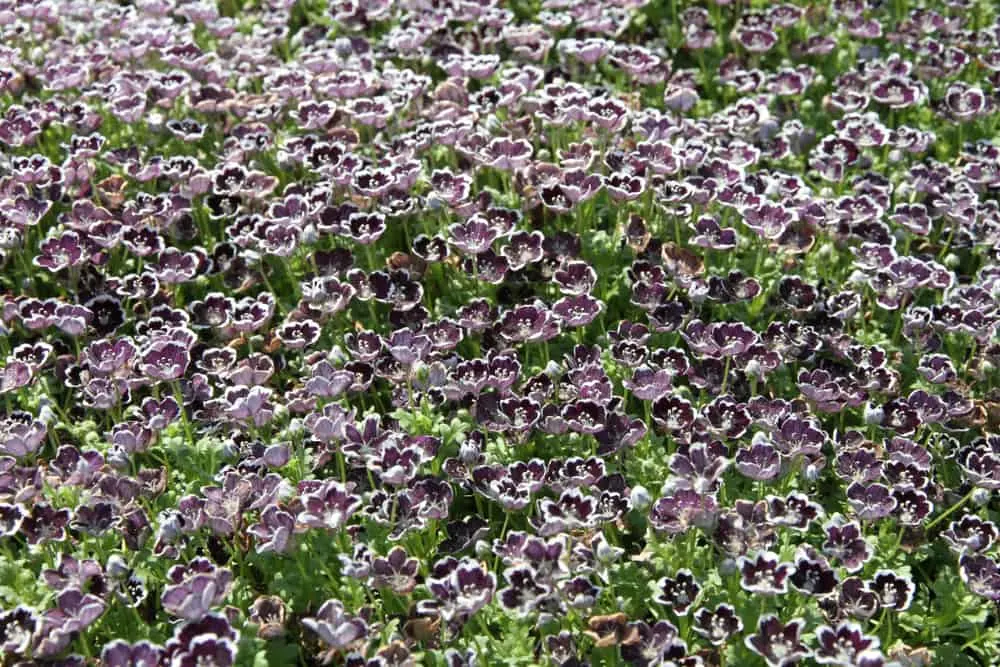
Penny blacks are low-growing annuals with purple flowers so dark, they’re almost black. They’re a unique addition to this list as these almost black flowers have white edges and centers. These slight twists create a highly contrasting feature, deepening Penny Black’s moodiness and mystique. The dark flowers pop even more against the plant’s bright green foliage.
Penny blacks are short annuals, growing to about four inches tall. Their height and uniquely colored flowers make them great filler plants. They are also great in containers and often used in hanging baskets. Penny blacks make perfect ground covers, adding unique flair at the base of taller plants.
These elegant flowers bloom throughout spring and summer, adding drama to your garden during the most colorful months. Penny blacks are hardy in USDA zones 2 – 11 and are generally worry-free plants.
15. Western Coneflower ‘Green Wizard’
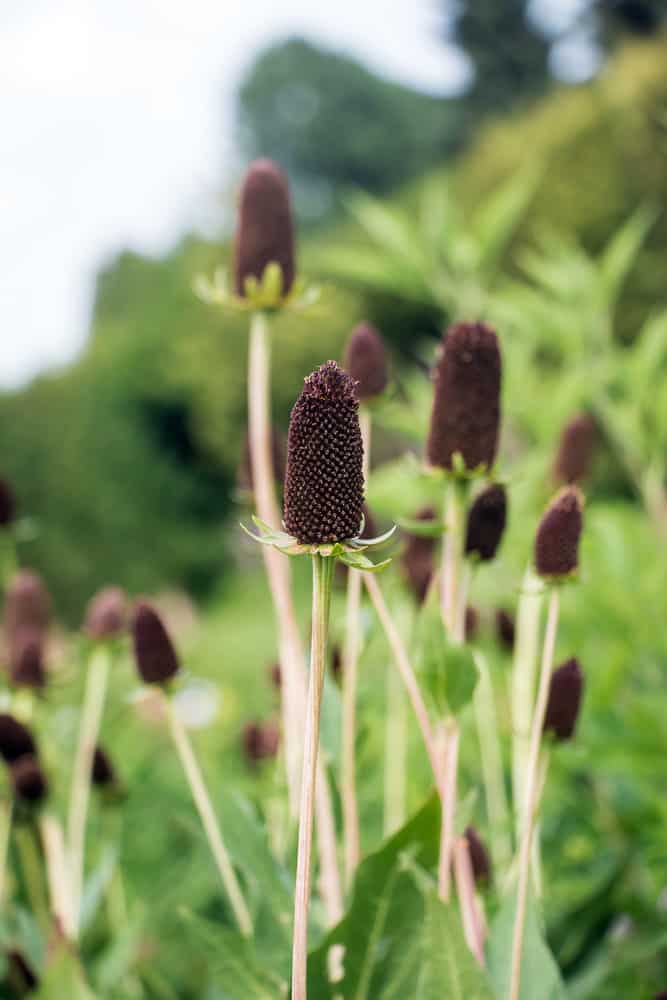
Coneflowers are spectacular plants, adding unique texture and shape to flower beds with their flaring petals and exposed middles. The Western Coneflower is one of the three different genera of coneflowers that exist.
The ‘Green Wizard’ cultivar is unique, however, with its acorn-shaped dark purple flowers. These cones sit on a plate of light green sepals, making the darkness of these flowers pop. Adding to their appeal is the rim of bright yellow pollen that increases contrast and attracts a myriad of pollinators.
‘Green Wizard’ grows to about five feet tall, making it perfect for the back row of flower beds. This coneflower adds a unique spin on both traditional gardens and modern flower gardens, creating a truly eye-catching spectacle.
Like most Western Coneflowers, ‘Green Wizard’ thrives in USDA zones 3 – 9, but it’s not drought tolerant like others in its family.
16. Cranesbill Geranium ‘Black Widow’
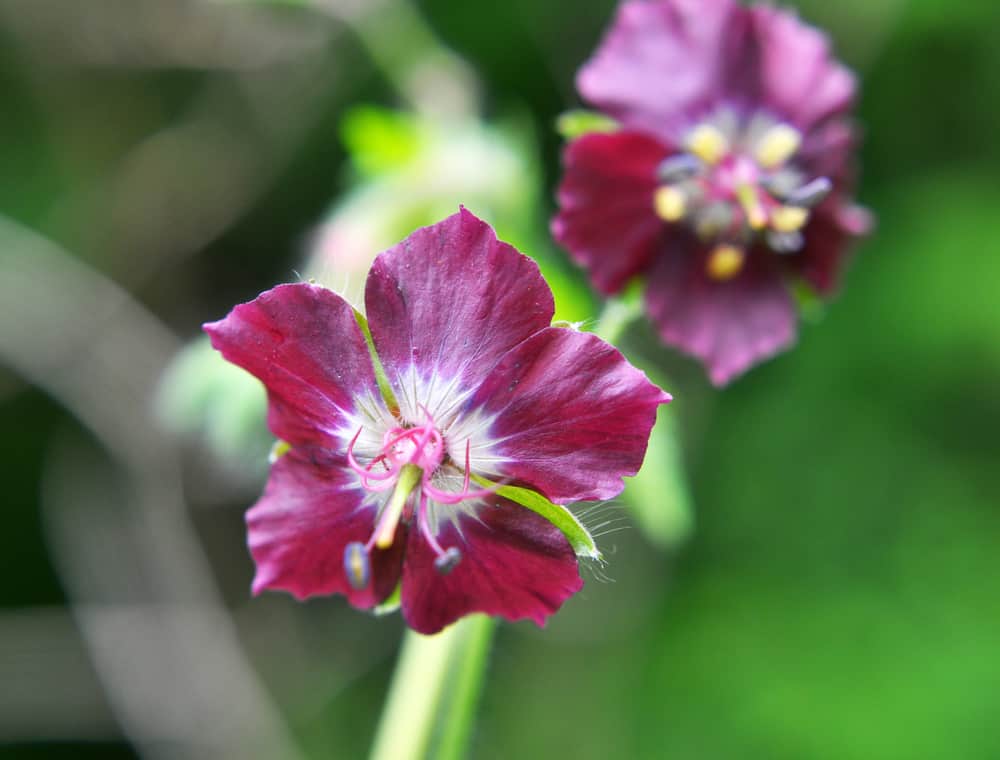
The Cranesbill Geranium has many names including ‘Black Widow,’ ‘Mourning Widow,’ and Dusky cranesbill. These dark names are due to the deeply colored flowers of this perennial. The flowers range from dark maroon to deep purple, with most being almost black.
The flowers of the black widow are relatively small, but they make a big statement. The petals either fold flat or are concave, leaving the intricate center of these blooms on full display. These eye-catching flowers rise high above low-lying crinkled and star-shaped foliage.
‘Black Widow’ prefers dry, shaded areas, perfect for woodland gardens. But their intriguing flowers will make a statement in all garden styles.
‘Black Widow’ thrives in USDA zones 4 – 8 and is relatively low maintenance. It’s also both rabbit and deer-resistant. This plant isn’t considered invasive, but it can spread rapidly in the right conditions.
17. Snapdragon ‘Black Prince’
Snapdragons are alluring plants and often come in a rainbow of bright colors. The ‘Black Prince’ is the perfect snapdragon for darker gardens wanting a splash of drama or a contrasting bloom. This dark snapdragon was first introduced to the world more than 100 years ago, making it the third heirloom plant on this list.
The ‘Black Prince’ boasts deep crimson flowers that suit gothic looks better than most. The stems of this alluring plant add to the drama with their bronze or maroon hue. This intense flower can reach about three feet tall.
‘The Black Prince’ blooms in late summer through to early fall, setting the perfect mood for the cooler months. It’s hardy in USDA zones 7 – 10 but can survive colder areas if grown as an annual.
This moody snapdragon looks wonderful in containers or when planted amongst other colorful blooms to create a contrasting flower bed.
18. Sweet William ‘Sooty’
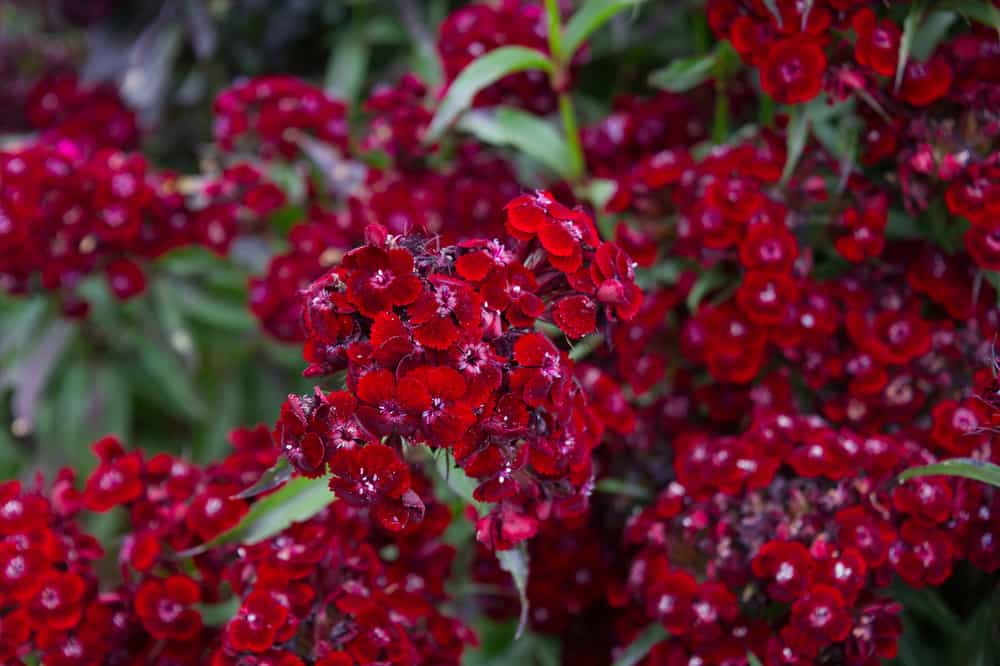
The ‘Sooty’ Sweet William is a dark twist on an old-fashioned cottage garden favorite. Its flowers are an interesting chocolate red, almost black color, and sit on top of a cluster of bronze leaves. The center of these moody blooms is a stark white, creating outstanding contrast.
‘Sooty’ treats your garden to its dramatic blooms throughout summer and spring and is an excellent companion for tulips. If you plant ‘Queen of Night’ Tulips alongside ‘Sooty’ Sweet Williams you’ll have a head-turning black flower display. It also makes a wonderful cut flower, allowing you to add drama inside your home, too.
19. Iris ‘Dark Vader’
While ‘Dark Vader’ isn’t as dark as ‘Before the Storm,’ its flowers are still almost black. ‘Dark Vader’ sports attractive deep violet flowers with a dark blue beard.
This cultivar is also unique as it’s a dwarf iris, expanding its landscaping uses. Its quaint size allows iris lovers to plant this dark beauty in smaller containers or the forefront of beds. ‘Dark Vader’ also loves water and adds a splash of drama to garden pond edges.
This plant is hardy in USDA zones 2 – 9, enjoying a wide range of climates. It will begin to bloom in mid to later summer.
20. Persian Lily
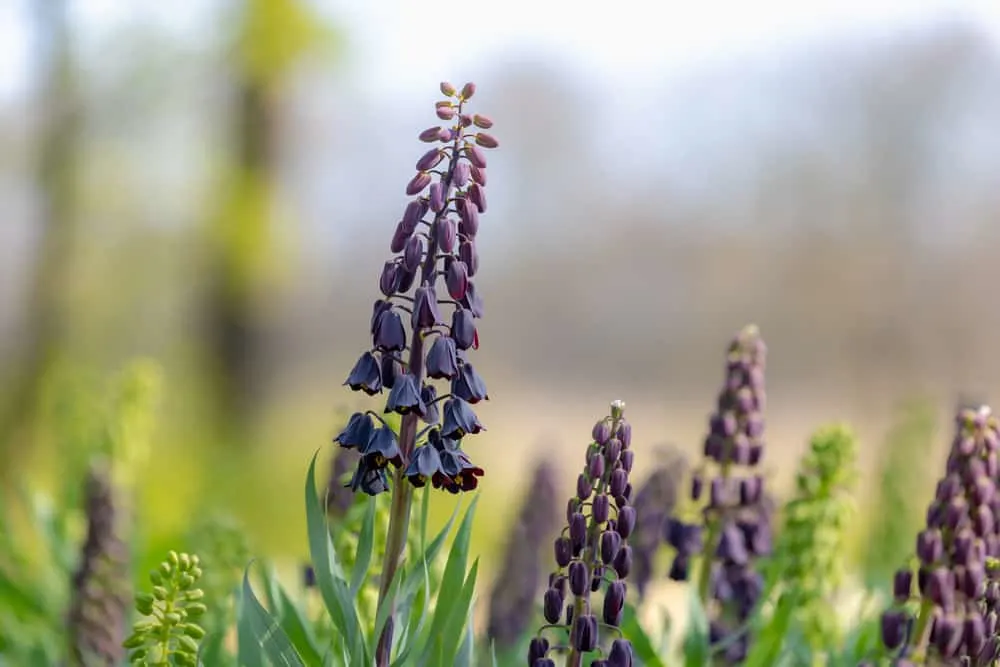
A flower with true dramatic flair is the Persian Lily. The bulbous perennial has blooms in many colors, but the most sought-after moody blooms are those with almost black, plum flowers. These flowers are bell-shaped and hang in groups of over 20 on tall spikes.
The tall softness of Persian Lilies adds drama to gardens without being overpowering. They make great additions to bulb beds and create an eye-catching display when planted in large groups. Its spring bloom time also makes it a great addition to spring beds, but its dark color allows the Persian Lily to stand out.
The Persian Lily thrives in USDA zones 4 – 8, an ideal low-maintenance plant.
